
How to look for records of... British Army medal index cards 1914-1920
How can I view the records covered in this guide?
How many are online?
- All
What are these records?
These records are index cards created by the Army Medal Office towards the end of the First World War. They record the medals that men and women who served in the First World War were entitled to claim.
There are over 5 million cards, held in series WO 372. Most of the cards are for soldiers in the British Army. The collection also includes:
- some British Army officers (officers had to apply for their campaign medals and may not have)
- Indian Army personnel
- British Army nurses
- Royal Flying Corps personnel
- Royal Naval Division personnel
- some civilians
Most of the cards contain information about campaign medals, which were generally awarded to all those who served overseas. However, some of the cards record entitlement to gallantry and long service awards.
It is Ministry of Defence policy to not issue medal replacements for service before 1920, irrespective of entitlement. You may be able to obtain duplicate medals from a coin or medal dealer. Alternatively, replica medals can be purchased from The National Archives bookshop.
How do I search the records?
You can search for an individual medal index card using the form below. You do not need to fill out every field to search these records; using only the last name and regiment number often works. Your search results will be displayed in Discovery, our catalogue. From search results you can select an individual record (by clicking on the title) and download it (£).
Your download will actually contain the images of six medal cards (with the exception of the Indian Army medal cards, which download individually), usually for six different individuals with similar or even identical names. Given this, if you are looking for the medal cards of two different people with the same surname it may only be necessary to download one image. In your search results, look for the Reference code. If the reference is the same for two separate individuals, you will only need to download one image for both cards.
Please note you can also search for, download and view these records on Ancestry.co.uk (£) and Findmypast.co.uk (£).
What information do the records contain?
It’s important to note that the cards do not contain much personal information. You may be able to find out more from the person’s service record, if it survives.
Campaign medal index cards
For each person the cards record:
- name
- rank(s)
- unit(s)
- regimental number
- medal entitlement
- often a roll reference that refers to a medal roll entry in series WO 329 which may reveal the specific battalion, brigade or battery in which the individual served
- often the first theatre of war in which they served and when they entered that theatre (if this part of the card is blank it usually means that the individual went to France in 1916 or later)
The card may mention the theatre of war entered, such as (1) France, but occasionally they only give the code number, or nothing if the date of entry is after 1916.
- Western Europe
- Balkans
- Egyptian
- African
- Asiatic
- Australasian
A complete list of the codes used on the medal index cards can be found on the LongLongTrail
Where additional remarks are recorded on a card, you may find information on:
- date of death
- date of discharge
- other remarks concerning the career or fate of the person
The original medal issue and medal receipt may also be noted. However, most of the cards record medal entitlement rather than the awarding of medals. If you want to check whether a person received a medal, you can consult the medal rolls (WO 329) which should be annotated with pencil ticks. These campaign medal rolls are available online via Ancestry £.
Occasionally, the medal card will confirm that the individual did not receive any medals, including many soldiers who went to France after 11 November 1918. They thought they were entitled and applied, but had their application refused.
Others failed to meet the required criteria for certain awards, had not served abroad, or forfeited their campaign medals due to a disciplinary infringement.
1914 Star
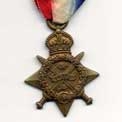
1914/15 Star

British War Medal
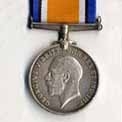
Victory Medal

Territorial Force Medal

Silver War Badge
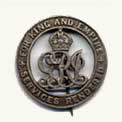 The Silver War Badge, sometimes erroneously called the Silver Wound Badge, was authorised in September 1916 and takes the form of a circular badge with the legend ‘For King and Empire-Services Rendered’ surrounding the George V cypher. The badge was awarded to all of those military personnel who were discharged as a result of sickness or wounds contracted or received during the war, either at home or overseas.
The Silver War Badge, sometimes erroneously called the Silver Wound Badge, was authorised in September 1916 and takes the form of a circular badge with the legend ‘For King and Empire-Services Rendered’ surrounding the George V cypher. The badge was awarded to all of those military personnel who were discharged as a result of sickness or wounds contracted or received during the war, either at home or overseas.
Gallantry award medal index cards
The gallantry award medal index cards are all in WO 372/23 or WO 372/24. They cover awards granted between about 1909 and 1931.
Each card provides:
- first initial and surname (the full first name is usually not given)
- rank(s)
- unit(s)
- regimental number
- medal entitlement
- date and page number of the London Gazette where the award was announced – search for this on The Gazette website
- Army Order number – Army Orders are preserved at The National Archives in the series WO 123
Most of the DCM, MM and MSM card indexes note in which operational theatre the award was won.
The card will not give the reasons for the award, but you might find a citation in the Gazette.
Some of the award dates are given as a numerical code – use the table below to interpret the codes.
Gazettes codes table
| Gazette code number | Date(s) |
|---|---|
| 59 | 11 February or 13 March 1919 |
| 60 | 18 or 24 or 30 January or 22 February 1919 |
| 61 | 29 March 1919 |
| 62 | 14 May 1919 |
| 63 | 17 June 1919 |
| 64 | 3 July 1919 |
| 65 | 23 July 1919 |
| 66 | 20 August 1919 |
| 67 | 20 August 1919 |
| 68 | 22 September 1919 |
| 69 | 16 October 1919 |
| Peace Gazette | 3 June 1919 |
| Prisoner of War | 30 January or 19 June 1920 |
Types of gallantry award
There were various gallantry awards, with different qualifications for each type:
Distinguished Conduct Medal
The Distinguished Conduct Medal (DCM), second only to the Victoria Cross, was awarded to all other ranks for exceptional bravery.
Military Medal

Meritorious Service Medal
The Meritorious Service Medal (MSM) could be awarded for services in connection with the war or for gallantry but not in face of the enemy.
Mention in Despatches

Types of long service medals
The Territorial Force Efficiency Medal (TFEM)
The Territorial Force Efficiency Medal (TFEM) was instituted in 1908 as a long service award for other ranks in the Territorial Force. Qualification for the award was 12 years’ service, with war service counting double.
Territorial Efficiency Medal (TEM)
The TFEM was renamed the Territorial Efficiency Medal in 1921 when the TF became the Territorial Army. The name and design of the award was changed again in 1930, becoming the Efficiency Medal (Territorial), sometimes noted as EM(T).
What do the records look like?
The medal index cards are displayed in sets of six (with the exception of the Indian Army medal cards, which download individually), usually for six different individuals with similar or even identical names.
Several different designs of medal cards were used but the most common type was the following:
Design 1
The left hand side of the card contains a printed list of the campaign medals. A note in the ‘roll’ and ‘page’ column meant the soldier was awarded that medal. You may also see ‘do’, which meant ‘ditto’.
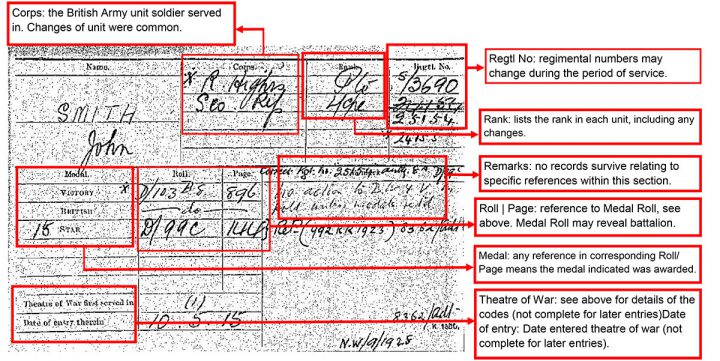
Example of the most common type of design for a medal index card (catalogue ref: WO 372/18)
Design 2
The essential difference with this design is that the medal entitlement is at the top right hand corner and the entire lower half of the card is left free for any remarks.
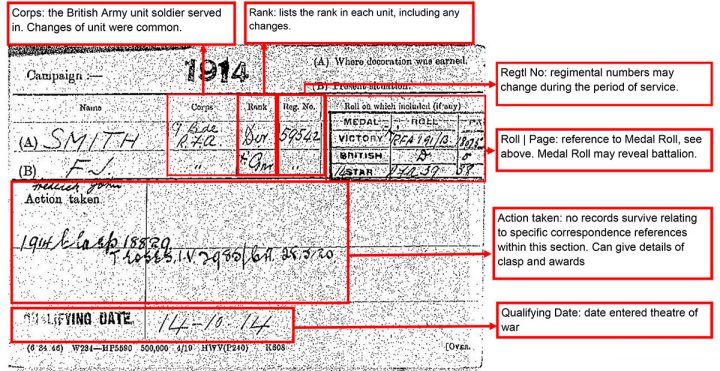
Example of the less common design of medal index card (catalogue ref: WO 372/18/154847)
Design 3: the Silver War Badge
This type of card was used for individuals who received the Silver War Badge only. The card contains information about an individual and often gives the date of enlistment, date of discharge and reason for discharge.
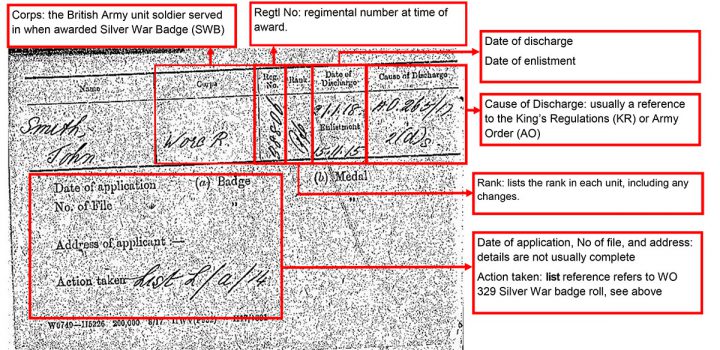
Example of a medal index card for the Silver War badge (catalogue ref: WO 372/18/154847)
Abbreviations
Medal cards often contain abbreviations and alphanumeric codes and we have listed some common ones below. The codes for those who saw their first operational service from 1 January 1916 onwards differ slightly from those who saw operational service before 1916.
For a more detailed list of abbreviations for rank and unit, you might find it useful to refer to the PDFs below or alternatively The Collector and Researcher’s Guide to the Great War by Howard Williamson.
Abbreviations table
| Up to 31 December 1915 | From 1 January 1916 |
|---|---|
| 1 | 1 Western Europe |
| a France and Belgium | |
| b Italy | |
| 2 | 2 Balkans |
| a Greek Macedonia, Serbia, Bulgaria and European Turkey | |
| b Gallipoli (Dardanelles) | |
| 3 Russia (4-5 August 1914 to 1-2 July 1920) | |
| 3 | 4 Egypt |
| a 4-5 November 1914 to 18-19 March 1916 | |
| b 18-19 March 1916 to 31 October – 1 November 1918 | |
| 4 | 5 Africa |
| a East Africa, Nyasaland and Northern Rhodesia | |
| b South West Africa | |
| c Cameroon | |
| d Nigeria | |
| e Togoland | |
| 5 | 6 Asia |
| a Hedjaz | |
| b Mesopotamia | |
| c Persia | |
| d Trans Caspia | |
| e South West Arabia | |
| f Aden | |
| g Frontier regions of India | |
| h Tsingtau | |
| 6 | 7 Australasia |
| a New Britain | |
| b New Ireland | |
| c Kaiser Wilhelmland | |
| d Admiralty Islands | |
| e Nauru | |
| f German Samoa |
Other abbreviations table
| Abbreviation | Meaning |
|---|---|
| ARZ | Class Z Army Reserve. In December 1918 soldiers being demobilised were first posted to Class Z. They could return to civilian life but knew they were obliged to return if necessary. The Z Reserve was abolished on 31 March 1920 |
| Cl | An individual had been sent a dated clasp. This clasp would go on the ribbon of the 1914 Star, or a silver rosette would go on the ribbon when only medal ribbons were being worn |
| Comm | Commissioned |
| EMB or Emblems | An individual had been ‘Mentioned in Despatches’ (MID) and at least two ‘oak leaf’ MID emblems had been sent to the recipient |
| KiA or Killed | If a soldier died in action, it is often marked on the card. Sometimes it will just say ‘Dead’ but occasionally it will not be noted at all |
| KR 392 | King’s Regulation 392 which covered causes of early discharge whether through ill health, misconduct or other reasons |
| Rep | Replaced. This is an unusual comment implying that the index card was replaced at some point |
| Retd or Rtd (sometimes ‘Retd undisposed of’) | Returned. If there was an error in the inscription, the medals would have to be returned to the Medals Office. Another reason for return was if the individual had moved house and the parcel was not deliverable |
| TE or T/E or T of E | Time Expired. This is when the soldier had reached the end of his agreed period of military service. It applies only to pre-war soldiers of the regular army or Territorial Force. These men were allowed to go home but from 1916 many TE men returned to active service as conscripted soldiers. |
Rank abbreviations used in the medal index cards (PDF, 0.62MB)
Unit abbreviations used in the medal index cards (PDF, 1.06MB)
Why can’t I find what I’m looking for?
Occasionally there is no regimental number recorded on the card, which may be the case if the person was an officer. In this case try searching by name and regiment only.
If members of the Royal Flying Corps did not see service overseas until 1916 or later, you will not find a medal card here. The Air Ministry maintained these medal records and they have not been transferred to The National Archives.
You may need to change the spelling of the words you are searching with; this is most commonly the case when searching for a sergeant, which was more commonly spelt as ‘serjeant’ at the time the cards were produced.
Officers had to apply for their campaign medal, so if they did not apply, there will not be a medal card.